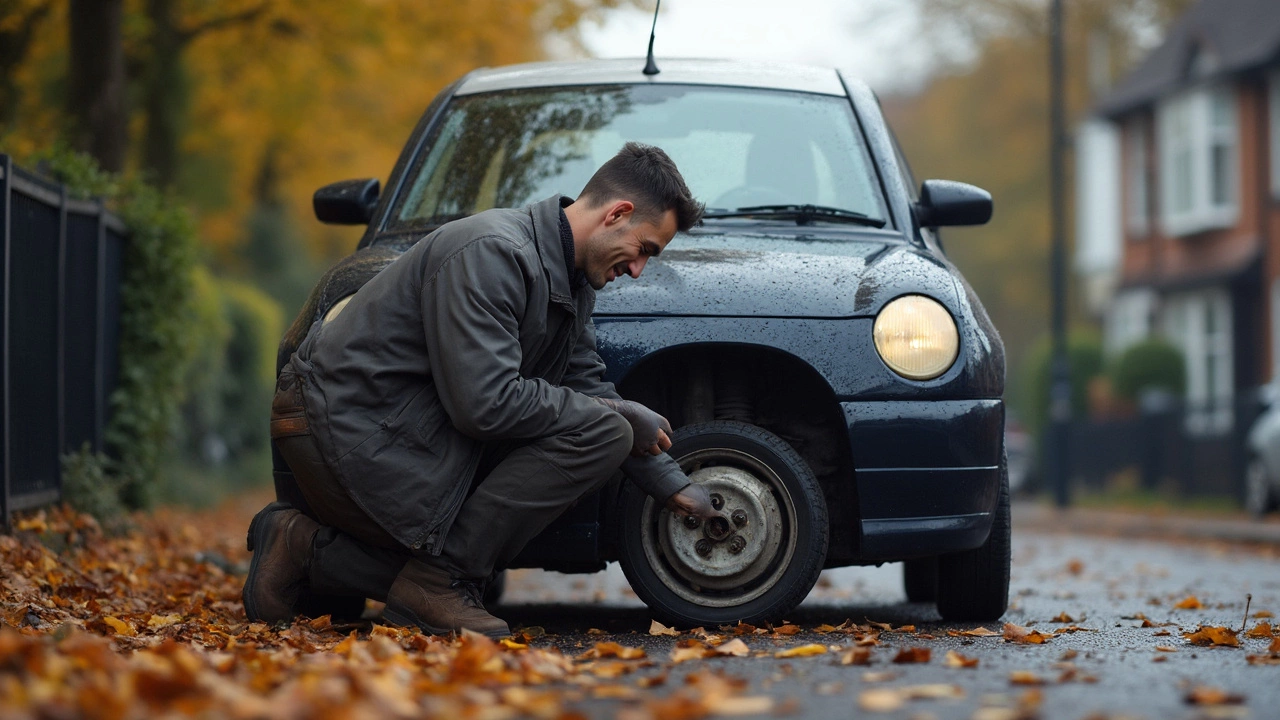Ever pressed your brakes and wondered if it's your front or back pads making that horrible squeal? You're not alone. Most drivers never think about their brake pads until something sounds off or feels weird. It's easier than you think to figure out – you just need to know what to look and listen for.
Front brake pads handle most of the stopping power in pretty much every car. They wear out faster than the ones in back. If you feel a strong vibration in your steering wheel when braking, that usually points to the front pads or rotors. Rear brake problems, on the other hand, tend to show up as a softer brake pedal or the back of your car fishtailing or making odd noises during stops.
Don't just trust your ears, though – a quick visual inspection can tell you a lot if you know what you're looking for. All you need is a flashlight and maybe a peek through your wheel. Spotting differences in brake dust, pad thickness, or even the pattern of wear can instantly point you in the right direction.
- Why It Matters Which Pads Are Worn
- Visual Checks: Front vs. Rear Clues
- Feeling the Difference on the Road
- Pro Tips for Checking Without a Mechanic
Why It Matters Which Pads Are Worn
If you mix up which brake pads are worn out, you could be putting yourself and everyone else at risk. The brake pads on the front do about 70% of the stopping in most cars, thanks to the way weight shifts forward when you brake. If your front pads are toast, you’re looking at longer stopping distances and maybe even total brake failure in extreme cases. That’s not something you want to figure out in an emergency.
The rear pads have an important job, too. They help balance out the car and keep it stable when you’re slowing down, especially in the rain or on a curve. Letting the back pads go too far can make your car swerve or slide, which is nerve-wracking and dangerous. People often ignore the rear brakes because they don’t wear out as fast, but that’s a mistake.
Worn-out pads can do more than just reduce your stopping power. They grind into the rotors and can cause expensive damage—sometimes hundreds of dollars more just because you waited too long to check which ones needed swapping. There’s also a bigger risk of overheating, warping, or even total brake loss if you keep driving with thin pads.
“Replacing brake pads before they’re completely gone is the best way to avoid much costlier repairs,” says the experts at AAA Car Care. “You don’t just protect your wallet – you keep your stopping power where it needs to be.”
So, knowing which pads are in trouble isn’t just a skill for the mechanically obsessed. It’s basic car safety. Save yourself money, stress, and maybe even avoid a nasty surprise on the road by checking the right set at the right time.
Visual Checks: Front vs. Rear Clues
You don’t need to be a pro to spot the difference between worn brake pads in the front or back. Most standard cars have larger and thicker brake pads in the front because the front brakes do most of the work. If you peek through your front wheel, the pads are usually much chunkier. Flip to the back and you’ll usually see smaller pads and sometimes even drum brakes instead, depending on your car’s age and style.
The easiest way to check? Look through the spokes of your wheels or remove the wheel if you’re comfortable. Here’s what to look for:
- Pad Thickness: Healthy brake pads have at least a quarter of an inch of material left. If the pad looks paper-thin (think about the thickness of a nickel or less), that’s a clear sign they need swapping soon.
- Dust Build-up: Notice a lot of dark brake dust on just your front wheels? That’s normal because front pads wear faster. If it’s mostly at the rear, your back pads might be going first—unusual, but possible.
- Grooves or Uneven Wear: Pads should wear down evenly. If one side is much thinner, something’s wrong with the caliper or the slide pins and you’ll want to fix that before replacing pads or rotors.
- Indicator Tabs: Many pads have built-in metal tabs that squeal when they’re low. You might see them poking out if you shine a flashlight behind the wheel.
For some vehicles, the rear brakes might use drums instead of pads, especially on older or budget cars. Drums are usually full of brake dust and don’t offer an easy visual unless you take off the drum cover. If you can’t see the pads at all, look for the inspection hole with a rubber plug in the drum backing plate. Pop that plug and you can get a quick peek at the brake shoe thickness with your flashlight.
The bottom line: front pads wear faster, leave more visible dust, and are usually easier to spot. Rear brakes can trick you if they're drums, but with a good flashlight and a little patience, you can check both without heading to the shop every time you’re curious.

Feeling the Difference on the Road
When it comes to figuring out if it’s your front or back brake pads wearing down, your car gives clear clues. If you pay attention while driving, you’ll notice these signs show up in specific ways, especially during different types of stops.
Most of your stopping power—nearly 70%—comes from your front brakes. That means worn-out front pads often make themselves known with obvious symptoms:
- Steering wheel shakes when braking, especially from higher speeds.
- Loud squealing or metallic grinding coming from the front, especially just before coming to a stop.
- A pulsating feel through the brake pedal when pressing down.
The rear brakes do their share of work too, but issues there show up differently:
- The car might feel unstable, or the back end could wiggle a bit when braking hard.
- A soft, spongy brake pedal is more likely linked to rear brake trouble, especially if there’s extra pedal travel before you stop.
- A scraping or harsher grinding noise rarely comes from the rear, but can mean the rear pads are pretty much done.
Here’s a simple cheat sheet to help spot the difference fast:
| Symptom | More Likely Cause |
|---|---|
| Steering wheel vibration | Front brake pads |
| Car pulls to one side | Front brake issue |
| Back of car wiggles under braking | Rear brake pads |
| Soft or sinking brake pedal | Rear brake system |
| Loud squeal from front | Front brake pads |
| Grinding from rear | Rear brake pads |
If you’ve never checked before, try braking at different speeds and pay close attention to sounds or weird sensations. Even my friend who’s never touched a wrench figured out he needed brake pads up front just from that shaky steering wheel. Listen, feel, and trust what your car’s telling you.
Pro Tips for Checking Without a Mechanic
You don’t have to be a pro to spot trouble with your brake pads. Even if you’ve never touched a wrench, there are simple checks you can do right at home. Here’s what you should try before calling in the experts.
- Listen Carefully: A high-pitched squeal or grinding when you brake is your car’s built-in warning. Brake pads have a wear indicator that squeals when the material gets too thin. Squealing from the front is usually the front pads, while strange noises from the back might mean your rear pads are done for.
- Look Through the Wheel: Shine a flashlight through the spokes of your wheels. You should see the brake pad pressed against the shiny metal rotor. If the pad looks thinner than a pencil (about 3-4mm), it’s time to swap them out. Compare front and back — front pads are usually bigger on most cars.
- Check for Uneven Dust: There’s usually more black brake dust on the wheels that do most of the stopping. If your front wheels are dirtier, those pads are wearing faster. Super clean wheels in the back and filthy ones in front? Time to check those front pads!
- Feel the Pedal: A pulsing pedal or vibration when stopping often comes from worn front pads or rotors. A mushy pedal or a car that pulls to one side can mean rear pad trouble.
- Brake Fluid Peek: Low brake fluid can be a sign that your pads are wearing out since the pistons push out farther as pads get thin. It’s not the only reason fluid drops, but it’s worth checking.
If you’re someone who loves a good chart, here’s a quick snapshot of wear rates between front and back brake pads for common vehicles:
| Car Type | Front Pad Life (miles) | Rear Pad Life (miles) |
|---|---|---|
| Small Sedan | 25,000 | 40,000 |
| Mid-Size SUV | 20,000 | 35,000 |
| Pickup Truck | 18,000 | 30,000 |
Just remember, front pads almost always wear out sooner. Save yourself a panic trip to the shop by checking them every oil change or at least twice a year. Stay safe, trust your senses, and don’t be afraid to get a little bit of brake dust on your hands.

